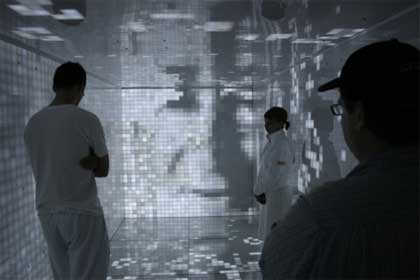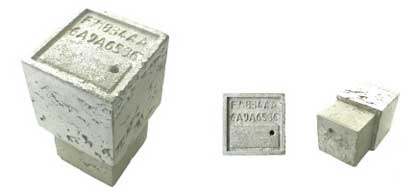Last episode of the Biorama day in Huddersfield where Capsula and the Digital Research Unit had invited artists to present the way their work explores and blends notions of life, science and digital realities.
Biorama (Part 1) + Biorama (Part 2)
 France Cadet, just back from an interesting-looking conference about theatre and robotics held in the framework of the 61st Festival d’Avignon, explained how she hacked robot dogs (she used I-Cybie which doesn’t come with a software like the Aibo, therefore re-programming the robot is a long and complex process) and turned them into transgenic and chimerical animals inspired by the advances of (bio)technology, in particular cloning experiments. Each robot raises questions about possible accidents, animal and human behaviour, artificialisation of life, side effects of cloning, dangers of xenotransplantation, etc.
France Cadet, just back from an interesting-looking conference about theatre and robotics held in the framework of the 61st Festival d’Avignon, explained how she hacked robot dogs (she used I-Cybie which doesn’t come with a software like the Aibo, therefore re-programming the robot is a long and complex process) and turned them into transgenic and chimerical animals inspired by the advances of (bio)technology, in particular cloning experiments. Each robot raises questions about possible accidents, animal and human behaviour, artificialisation of life, side effects of cloning, dangers of xenotransplantation, etc.
Video
COPYCAT is half dog, half cat. It is independent and clean like a cat while being affectionate and playful like a dog. The robot was inspired by “Cc” the first kitten cloned in December 2001 at Texas A&M university. The breakthrough has made it possible to clone your favourite dying or dead pet and to produce a pet “à la carte”.
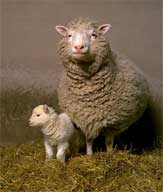
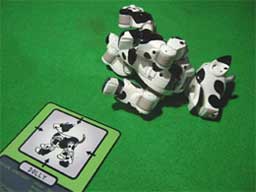
DOLLY has a more complex origin, half of it is a dog, then it is 30% ewe, 15% cow and a tiny portion of sheep. The dog is named after Dolly the sheep, the first mammal cloned in 1996. Both sheep and bovines specimens have encountered difficulties for their cloning: BSE: Mad Cow Disease, Progeria, premature ageing (because her donor sibling was six years old when the genetic material was taken from her, Dolly may have been genetically six years old at birth), abnormal size and various pathologies. This species aims to cure all the side effects of cloning and deterioration of DNA. However, not everything went according to plans and the dog-cow is suffering from BSE and eventually dies on its little pad of artificial grass.
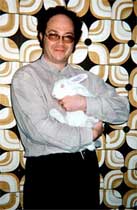
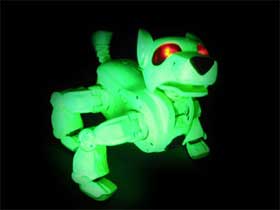
GFP PUPPY had just 1% of Green Fluorescent Protein gene transferred into its genome. GPF is present at the natural state in jellyfish, and commonly used to mark the cells. In this case, the gene gave the dog a phosphorescent coat. After the fluorescent mouse and Eduardo Kac‘s Alba rabbit. “GFP Puppy” marks the beginning of a new age of animal cloning, that of more evolved and complex species.
XENODOG is half dog, 45% pig and has also 5% Nude gene.
While the pig is smart and sociable enough to make the perfect pet, it is also the best species to supply organs for xenotransplantations. XENODOG has also the same genetic defect as the nude mouse that prevents him from growing hair and from immunologically rejecting human cells and tissues.
JELLYDOGGY. This genetic mutant is 90% dog with 5% jellyfish and 5% chameleon. 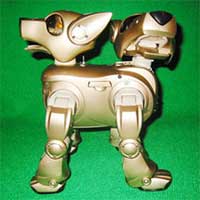 Its genome has been enhanced with the gene of a hydrozoan (jellyfish family) as well as the gene of the chameleon, well known for blending in with his environment. This peculiarly enables him to adapt to an aquatic life.
Its genome has been enhanced with the gene of a hydrozoan (jellyfish family) as well as the gene of the chameleon, well known for blending in with his environment. This peculiarly enables him to adapt to an aquatic life.
SCHIZODOG has worryingly been “enhanced” with 25% Dr. Jekyll genes and 25% of Mr. Hyde.
The cloning experiment helps increase our understanding of psychological disorders such as multiple or split personality disorder, bipolar disorder, schizophrenic disorder… it also makes us aware of genetic influence on the psychology of twins, Siamese twins and clones. The study of the two headed dog may suggest promising forms of treatment and perhaps, in the near future, may help predict the outcome of several mental illnesses.
Along with the dog genes, the FLYING PIG is 40% pig, and has 5% nude and 5% human genes.
Inspired by Stelarc‘s extra ear, Symbiotica’s Pig Wings and the nude mouse with a human ear attached onto its back. Initialy designed to serve as a model for tissue and cartilage engineering and to replace a missing or malfunctioning part of the body, those ear-wings prosthesis, made out of muscles, soft tissue and flexible cartilage, can actually enhance the body’s fonctions. From now on reconstructive surgery belongs to the past, time has come for augmented surgery.
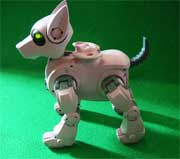
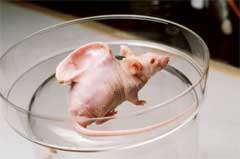
The last presentation of the day was from etoy agent Marcos who briefly recalled TOYWAR the most successful performance of the group. Toy retailer eToys.com sued etoy for having a similar domain name to their own (etoy.com.) They first offered incresingly big sums of money to get the domain and when they realized it wasn’t to sell, they decided to launch a rather dirty legal battle. After several weeks, a market capitalization loss of $4.5 billion dollars, eToys dropped the lawsuit and the etoy website returned to operation.
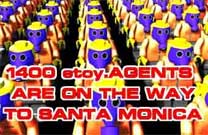
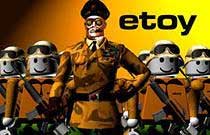
But Marcos was mostly there to talk about MISSION ETERNITY, an ultra long term project started by etoy.CORPORATION in 2005. Its theme is the cult of the dead in the digital age, its chore idea is to create a digital portrait and make it eternal it through a p2p system and its main pilar is the arcanum capsule.
Video summary.
The ARCANUM CAPSULE is reserved for charismatic pioneers of the information age: the M∞ PILOTS (the process can not be offered to the broad public yet as it is too artistically intense, expensive, and requires the participation of a whole range of trained etoy.AGENTS). So far only 2 TEST PILOTS are in the pipeline (microfilm pioneer Sepp Keiser and writer Timothy Leary).
The M∞ ARCANUM CAPSULES contain digital fragments of the life and “soul�? of the USERS and enable them to maintain a presence post mortem as data particles hosted in the shared memory of hundreds of networked computers and mobile devices such as cell phones of the so-called M∞ ANGELS, people who contribute a part of their digital storage space to the project. As long as humanity exists and people are connected, the memory will be preserved.
Now how can you make the remains eternal in a more tangible way? By having them enter some art institution through physical artefacts. They would get from the family ash once the pilot has died and incorporate it into sculptures called M∞ BRIDGES that link physical and memory spaces as well as life and death. Innovative technology and artistic quality might appeal to art collections, libraries and museums. Conservation would thus be outsourced to protected environments and experts financed by governments, foundations and private collectors. The ash of the deceased would be mixed with cement and then used as dead pixel on the big screen inside the sarcophagus.
The first series of M∞ BRIDGES are dominated by visual output (SARCOPHAGUS and MISSION CTRL) and close to traditional art forms. The second series will be based on antenna principles: broadcasting radio signals (voices of M∞ PILOTS), WLAN, Bluetooth and cell phone content. They will introduce a new generation of public interactive art.

